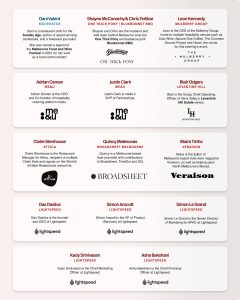Table Talks Melbourne: A Discussion Over Dinner with the Leaders of the Hospitality Industry

Early this year, Lightspeed hosted the Table Talks event where we brought together some of the leading figures in both hospitality and tech to talk about the hospitality industry, the issues faced in recent times, the current state of the industry, the future and how technology can work alongside a business owner to help remove a lot of the gambling and uncertainty that a hospitality business can face, day-to-day.
Hosted across a few hours at Melbourne’s Hazel restaurant, our guest speakers include:
Speakers

Our industry experts talked over the following key issues facing hospitality in the modern age:
- Industry challenges: Rising costs, labour shortages, and resource planning
- Sustainability: Best practices on operating sustainably and the barriers that hinder this
- Customer behaviours: Changing trade trends and using data to keep customers coming back
- Technology adaptation: How tech is shaping the future of hospitality
- Moving the industry forwards
Industry challenges: Rising costs, labour shortages, and resource planning.
Navigating costs and labour shortages are constantly on the minds of many operators in the hospitality industry. Where Covid was supposed to be the hard bit, the crunch of ever-increasing costs, paired with a cost of living crisis means that this period of frugality continues as customers aren’t able to spend as much as they used to, and this leaves a lot of hospitality businesses squeezed in the middle.
Operating costs vs consumer expectations
These are the very real difficulties of communicating this to customers. A simple look at your local supermarket or the petrol station shows that it’s clear that prices have gone up in every sector. Yet there is a disconnect between the reality of operating with ever-increasing costs, and the customer’s understanding that seems unique to the hospitality industry.
“The price of meat has doubled…”
Chris Terlikar: “When we first opened, we were charging $10 for 100g, and now we’re charging $15 for 100g, so the price of meat has doubled, but we’re only charging an extra 50% on top, so there are a lot of challenges. Even firewood. We were paying $350 for a ton, now we’re paying almost a thousand.”
Shayne McConachy: “Trying to communicate that to our customers, you know, through price increases on the menu isn’t really received well. And sometimes it’s hard not to take it personally, trying to sort of pinpoint, have we done something wrong?”
Power in collective action
Blair Odgers: “Customer’s expectations, I believe, are deeply embedded into previous behaviours. It’s really hard to change prices without getting direct feedback.
“This is where the collective just has to say, I’m sorry, we would love to serve a pot and a parma for $30 or $25, but that world’s changed and we all have to, as a collective, just accept that it’s now $32, $35. The customers desire our experience and they will adapt.”
Climate of fear
There are significant decisions being made by hospitality operators, but they are being made in a climate of fear—not knowing whether their gamble will pay off, trying to claim a piece of an ever-decreasing pie as customers opt to stay in more often. It’s something that the tech side of the industry has seen reflected in the data.
“…a self-fulfilling prophecy.”
Adrian Osman: “We currently process one out of 20 orders in Australia now—so about 5% of the spend—so we get a pretty good sample size. We’re seeing beer get hit pretty hard at the moment. You’ve seen all the media about $15, $16, $17 pints, and the media just loves that shit.

“They just want to get that as viral as they possibly can, so I think it’s a bit of a self-fulfilling prophecy. Retail prices, they’re taxed highly, but they haven’t gone up enough, so it makes sense that, on a Wednesday, people are going around to their friends house now and buying a six pack for what they view as a five times cheaper experience.”
But it’s not all bad news. Where the experience leans more heavily on the things that require a more specialised skill set, consumers still appear willing to head out to venues, rather than staying home.
“What we’re hearing from customers is their focus on food has never been higher, and we see this in our data as well that food and cocktails—things that people aren’t as good at doing at home—tend to be drawing people out for experiences more.”
These gambles mirror customer behaviours with venues beginning to forego a potential, one-off payday in the name of keeping costs to a minimum.
“…is it even worth opening?”
Adrian Osman: “There’s a lot of fear around what you do with the weekdays and we’re seeing that manifest in venues closing on certain days, so there’s more and more closed on Monday and Tuesday now, and just trying to concentrate their labour model and the opening model to work on the weekend. You can do great, appealing offers that will build your brand, but you’ll run on break-even or a loss on those weekday nights to sustain that, so is it even worth opening?”
Sustainability: Best practices on operating sustainably and the barriers that hinder this.
Sustainability. It’s something that’s always on the minds of hospitality venues. The industry is making efforts towards operating more sustainably, but there are barriers to doing it right, and convincing your customers that what you’ve put in place is actually going to make a difference and, as such, a lot of different things we, as an industry, can do.
“We’re including the guest being part of the solution.”
Claire Stenhouse: “Cows destroy the land so, because of that reason, we don’t serve any animals like that. In fact, the vegetables are more expensive than meat. So we have our hunter guy that sends us down the byproduct of the fashion industry, and we’ve got something called the Eat The Problem Lasagna, the problem being all these animals that come over to the land with their hoofs and things like this.
So we’ve got wild boar, venison and buffalo—all prevalent in Australia—but should not be here, so we put them in a pasta. It’s the most sustainable way to solve the problem.”
More than one type of sustainability
But often people talk about sustainability as though it means one thing, but there are so many ways of looking at it and they’re all important. One part is the sustainability of a business model; would this way of operating be something that you could keep going in the long run? And the thing is, both ideas go hand-in-hand. A business model that strives towards providing an environmentally sustainable future can be sustained itself by staff and customers that strive for the same thing.
“Is it something that customers care about? Categorically, yes they do.”
Leon Kennedy: “I think they all are interconnected, you cannot just isolate one, and I think in terms of environmentally, it’s just got to be high on the agenda. Is it something that customers care about? Categorically, yes they do.”
When it comes to creating sustainability in a business sense, creating your own supply chain is an extremely viable way to ensure that when consumers patronise one of your businesses, another also benefits.
“Why would I go across the street, even to 7-Eleven, and buy a coffee for a dollar when I can actually support this cause?”
Leon Kennedy: “Ten percent net profit from the roastery goes to the farm, every one of our customers is supporting it. So when we put up a few communications around how when you buy a coffee here, it’s really supporting this amazing business down the road, the sales went up crazy. It went from 10 kilos, up to 50 kilos. And suddenly now everyone in that building was like, well, why would I go across the street, even to 7-Eleven, and buy a coffee for a dollar when I can actually support this cause?”
Sustainability from a staffing perspective
When you employ the right business models—the type that resonate on an emotional level within your team—this can lead to lower staff turnover as your employees are more motivated to be part of a bigger picture.
Leon Kennedy: “You cannot ignore the growing demographic of people that are just more conscious, right? And you might not care about it but you know who does? Your customers and your staff. They really, really care. So if you want to actually motivate your staff, and you want to not have really high turnover, and you want to give something to your customers that they really appreciate, that’s the thing you have to do.”
Customer expectation
With environmental sustainability becoming more popular, there’s an emerging desire to dig deeper and hold businesses even more accountable as customers become more aware of the various methods and techniques that can be used to create a more sustainable landscape.
Moira Tirtha: “I think it’s really becoming an expectation for consumers that, if you are charging a particular price point for food, then you’re going to be also sourcing it from somewhere that is sustainable, in some capacity.”
Quincy Malesovas: “It’s not just like, is this local? Is this sustainable? But are you peeling these vegetables and then getting rid of the excess or are you actually utilising those within your restaurant in some other way?
I think you’re seeing more and more places that are able to answer those questions, and they are, sort of, holistic in their approach to how they utilise every aspect of every ingredient that they’re using.”
Customer behaviours: Changing trade trends and using data to keep customers coming back
The hospitality industry is always on the lookout for strategies to build up some resilience in an unpredictable landscape. Finances and technology can intersect to offer some strategies for navigating uncertainties and make this landscape a little less uncertain in the future.
With changing customer behaviours, it’s becoming increasingly difficult to plan ahead for the coming weeks or months. With so much uncertainty around trade patterns, focus is beginning to shift towards creating less uncertainty so that hospitality businesses can plan ahead with a degree of confidence—something that’s easier said than done.
“…people just aren’t going out as often.”
Justin Clark: “From the data that we’ve been seeing, when people are going out, they’re still happy to spend a reasonable amount of money, and we’re probably seeing the average spend and average transaction as high, or higher than recent years, but people just aren’t going out as often.
So I think where the interesting intersection is here—and I know this is a space that Lightspeed is focusing on as well at the moment—how can you actually start to use transaction data, and data that you’ve got on customers, to drive more bums on seats and keep people coming back?
Opportunity with data
With more and more data becoming available to hospitality operators, there are increasingly useful ways we can use this data to inform our decisions. The key here is in how we interpret the data in the most useful way.
Justin Clark: “Probably where I see the big opportunity here is a lot around connecting all of this customer data—the digital world is having a huge play in this as well at the moment—but it’s really around pulling all of that into one, tidy source and using the data really well.
Not in a nasty, evil way, which often data gets thrown into, especially in hospitality where operators are really hesitant to use it in any way. But trying to leverage the transaction data that operators have to really make sure that they are driving those return visits at least, and leveraging the data really well to create the experiences when they come in.”
Creating certainty, piece by piece
Sometimes when presented with data, there can be a feeling of becoming overwhelmed at the sheer amount and there can be a picture painted of the issues being indicative of a large problem within the business that needs to be tackled as one.  But that isn’t necessarily the best way to use data to fix a problem.
But that isn’t necessarily the best way to use data to fix a problem.
“You won’t understand the whole thing (but) you can create pieces of certainty.”
Simon Arscott: “The point that I really resonate with people through is you can view the whole thing as uncertain, or you can start to fractalize the problem and pick up pieces to create certainty. How do you get certainty of like, how many of the people that come to me return—come back? Can I understand a piece of that puzzle and why do they come back? And you won’t understand the whole thing. You can create pieces of certainty that you can bank on that give you more space to move.”
And it’s this use of customer data that could prove vital in the struggle for return business. When looking at the relevant data in isolation, strategies can be formed to use data in creative ways, and provide a path to salvation.
Technology adaptation: How tech is shaping the future of hospitality.
There’s tech that starts to seem obvious once you think of it. And then there’s tech you can’t quite imagine. The Lightspeed Hospitality Report has revealed that the vast majority of venues, 91%, are already using AI in some capacity. But there are barriers that were noted around staff training and adoption, so how can emerging tech like AI gain a lasting foothold in the industry and shape the industry of tomorrow?
“The biggest positive is that AI can’t replace what restaurants do.”
Adrian Osman: “I think people are overestimating how quick AI will have an impact, but underestimating how big that impact will be in job disruption and many societal things. It’s going to be a lot more than people anticipate. The biggest positive is that AI can’t replace what restaurants do.
“There’s an amazing defence built into the romance of hospitality that can never be replaced by technology.”
The coolest thing about the restaurant experience is that that doesn’t really change; 100, 200, 300 years from now, people will still go to pubs and restaurants and have a great time with their family and friends. There’s an amazing defence built into the romance of hospitality that can never be replaced by technology. It will always be on the peripheral. You can do cool stuff with AI, you can personalise the menu or the experience, there’ll be robots making coffee more, for sure, but the experience is going to be human still.”
But AI is still in its infancy and businesses are still figuring out not only how to use it, but how best to apply it in a way that can truly help their business.
“I don’t think anyone quite knows yet what that power is…”
Simon Le Grand: “I think what’s really interesting now with the rise of AI is people are now figuring out how to harness that, not just in the business world and tech world, but in the hospitality industry as well.
I don’t think anyone quite knows yet what that power is and how it can be leveraged, but people are really curious, and it’s probably shed a new wave of light on how can I actually look at the information in my business and assemble it into something that I can actually make decisions ahead of time, rather than realising before it’s too late that I need to change something.”
Changes like this—the type that can not only save you time, but also save you from unpredictability—are undoubtedly on the way. Lightspeed is already in touch with the pain points that AI could help ease in the near future, meaning good things are on the horizon for hospitality businesses.
Dax Dasilva: “We know what the pain points are. We see the onboarding for a customer, right now, is anywhere from 30 to 65 days to get set up and AI can probably reduce the steps where you have to invest a lot of your staff in your own personal time. I think that’s the big opportunity for ultimately benefiting businesses on a continuous basis.”
Self-discovery with AI
With the broad spectrum of AI’s potential applications seemingly endless, there are effectively no rules on what you could potentially allow the emerging tech to do for you. This extends all the way to identifying what it is your business is at its very core.
Leveraging ChatGPT to produce concise identity statement for the venue
Leon Kennedy: “One of the things I was really keen to do here, but just never found the time to do it, was when we were trying to really dive into the identities of our restaurants, what is the two-line identity statement for the venue? And so we wanted to use a bunch of different ways of trying to figure that out, and one of the things that we wanted to do is just grabbing all of our customer reviews and just literally copying and pasting them all into ChatGPT, and saying tell me the things that you can pull out of this.”
Keeping your build on-budget with the help of AI
And as AI becomes more sophisticated and more trustworthy, the applications for the hospitality industry begin to grow into the realm of huge savings from the outset of establishing a new business.
“…you can actually use AI to solve that for you…”
Leon Kennedy: “I think the possibilities are endless, right? Where I would then take that is maybe into building a new venue. Say, for instance, we get to the stage where we’re really clear on the concept, I’ve seen the architect, and now we’re just getting the building quote in, and say, for instance, we want that quote to be $700,000, and it would obviously never be that, right? It’ll always come in over.
I think it’s a really good way that you can actually use AI to solve that for you, to be able to say, what are the ways that we can actually bring this quote down, get it into a smaller ballpark?”
Moving the industry forwards
It’s clear that the hospitality industry is facing the same problems as its customers in rising costs and an ongoing battle with inflation, but that also they are navigating these issues with less leniency shown from consumers than other industries.
But, there are ways that technology can help ease the burden and take away some of the risk from vital decisions, whilst it’s clear that hospitality, unlike other industries, has an in-built safeguard against total control being given to AI and that is its inherent humanness.
Bringing together these important thinkers from hospitality and technology for events like this has highlighted the pivotal role of technology in mitigating uncertainty and empowering hospitality business owners.

News you care about. Tips you can use.
Everything your business needs to grow, delivered straight to your inbox.


